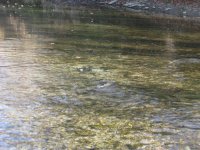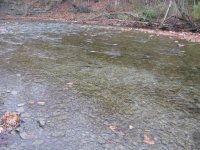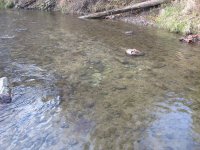I think any of those could be redds, but I am not experts enough to say definitively. If there were a paired trout on it, my belief increases. Then again, sometimes the flow and contour of a river/creek make redd-like areas.
I think there is no doubt the steelies spawn in the creeks-- they must. I think there is a low likelihood that many spawn are successful. And by successful, I mean to the point of returning fish to the lake.
Several things hinder a successful spawn as I see it: lack of prime spawning habitat; spate-nature of the watersheds; water temps, unnatural spawn/redd disturbance. Regarding disturbance, I suspect there would be relatively greater success with spawning if thousands of anglers were not marching along and in the creeks throughout the incubation period. But even if left undisturbed, there are not alot of pebble or cobblestone areas. There is a shale "gravel" but it isn't ideal. The water temps is a concern in that the fry cannot remain in the stream throughout the Summer, so they either perish trapped upstream when Summer flows and temps reach critical levels, or are forced out in the lake where they are nothing but little fishes on which bigger fishes feed.
Shame on me, but I don't even look for redds when tromping around the Erie Tribs. That said, I haven't fished many tribs-of-trib, nor any of the miles of water that are posted and not disturbed, particularly in the upper reaches. I imagine if I had the chance to fish rarely used water, I might still be careful in ripping up a perfectly good redd, even though the chance of long-term survival of the eggs/fry is poor.






